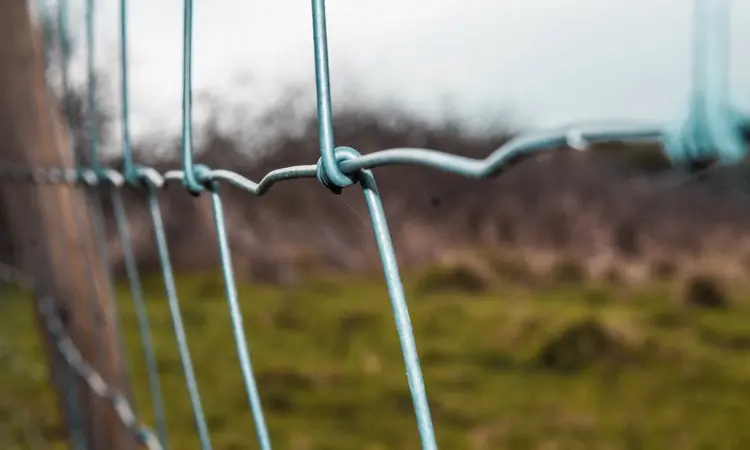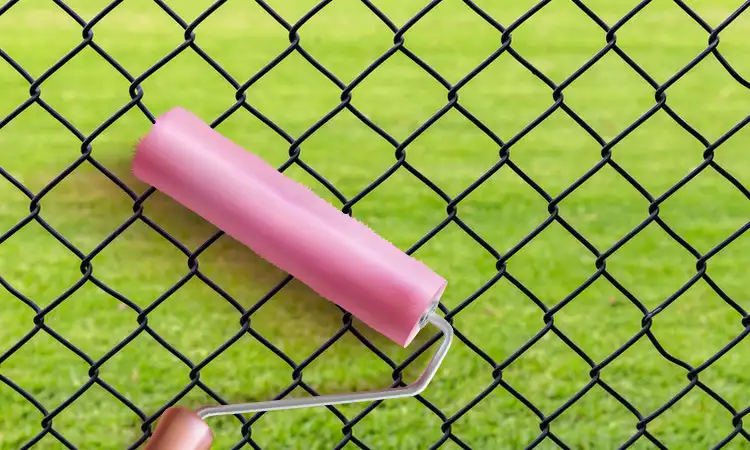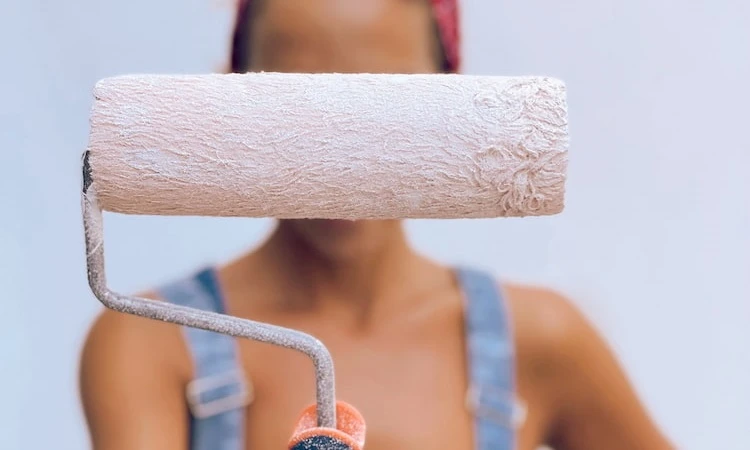A chain link fence is probably one of the most difficult substrates to paint. Otherwise, you would not have landed here looking for answers.
Before proceeding with your project, you must have some ideas on how to paint a chain link fence. Or else, you may just end up wasting your resources and time.
First and foremost, you must ensure to clean the fence of rust or old paint. Then, you can spray the chain link with a rust inhibitor.
Afterward, you can apply the paint of your choice using a paint roller. Paint rollers are the most efficient and economical method for painting your chain link fence.
You will waste less paint if you use a roller than a sprayer. However, you might still need the help of a paint gun to paint the post of your fence and the other areas that the roller could not reach.
Your best paint choices for your chain link fence are epoxy, urethane, and direct-to-metal (DTM) acrylic paints.

Can You Paint a Chain Link Fence?
If you wonder whether you can paint your old chain link to make it look decent again, the answer could be a YES or a NO.
If the chain is already very old, rusty, and deteriorated, don’t force to paint it. It is best to replace it.
However, if you check that the fence is still salvageable, you can prolong its life by painting it.
Painting your chain link fence may not be that easy. If it is a re-painting job, you need to ensure that you remove the old paint.
Otherwise, the new paint will not stick properly to the substrate. Cleaning the old paint can be a taxing job. However, you can shop around your local paint stores and look for paint strippers to help you with the job.
You also need to identify the material of your chain link fence. There are also chain link fences made from plastic or coated with vinyl.
Knowing the substrate will help you determine which paint to use for better results. Each type of substrate may require a special type of paint.
Before you decide to paint your old chain link fence, you need to think about how you will proceed carefully.
As the job is not the easiest painting job to do, you might want to consider hiring professionals to do it. These guys do this job almost daily, so they perfectly know how to deliver good results.
However, if your chain link fence is not huge, you can consider doing it yourself. I think 150 square feet of fence is manageable for a DIY.
Then again, if you are not entirely sure whether you can pull it off or not, seek some professional help.
How Much Will Painting a Chain Link Fence Cost You?

Many things influence the cost of painting or re-painting your chain link fence. It depends on how you plan to do it.
If you hire a professional or a contractor to do it, there is no doubt it would cost you more than doing it yourself.
The advantage of having a professional is the result’s quality. On top of this, you will not feel the stress of having to do it yourself.
If you do the job yourself, what costs will you incur? Well, there are many things you will need, including the paint, roller, rust inhibitor, wire brush, and many others.
These add to the overall cost of painting your chain link fence. The dimension of the fence also dictates the cost of the project. The wider the area to be painted, the more resources you need.
In a conservative estimate, you would likely spend between $60 and $80 to paint 150 square feet of chain link fence.
Not as costly as hiring a contractor that would charge you $200 for the job, even higher.
It would save you some dimes to paint the fence yourself. Although, you need to be mentally and physically ready to do it.
What Kind of Paint Works Best For a Chain Link Fence?
There is another type of chain link fence that is vinyl or plastic-coated. But for this article, I will focus on the metal chain link fence.
If you wonder what types of paint are best to use, I can only suggest three: epoxy, urethane, and direct-to-metal (DTM) acrylic paints.
Epoxy Paints
Have you ever wondered how street railings last for many years without deteriorating?
Thanks to the epoxy coating that protects them from abrasion, corrosion, and extreme weather elements.
Most outdoor metals use epoxy paint due to its durability and resiliency.
Epoxy paint can help guard your chain link fence against corrosion. The finishing product can withstand ultraviolet exposure.
Furthermore, it resists water and moisture. It makes your chain link fence waterproof to some extent. Other benefits of epoxy paints include chemical resistance, impact resistance, and easy-to-clean quality.
Additionally, epoxy paint is also impact resistant. Does it matter when you are only painting your fence? Of course, it does.
You will never know what objects will come in contact with your chain link fence.
Urethane
Urethane paint is arguably the most durable automotive paint. It is a friend to auto repair shops and car painters.
This paint is well-suited for metal surfaces. It prevents the metal from harsh weather conditions and other elements. It is also an ideal paint for outdoor surfaces like your chain link fence.
If urethane paint comes with many benefits, there are also some drawbacks. It is not the most affordable option.
It is not the most expensive type but also not very affordable. Some users report that the paint will exhibit a plastic-like appearance as it ages. Additionally, it is highly toxic.
The high toxicity level of this paint is one of the reasons why some people don’t use it.
The toxic fumes do not only provide immediate health reactions. The toxins can end up in your lungs, and it takes a long time to clean your lungs from them.
DTM Acrylic Paint
Another paint you can use for your chain link fence is acrylic Direct to Metal (DTM) paint.
Because of the challenges in painting metal surfaces, paint manufacturers created a formula for metal substrates. As the name suggests, you can paint it directly on your fence.
There are two types of DTM paint formulas: acrylic and oil-based. Although you can use either of the two, I prefer that you use the acrylic variation because it is health and environment-friendly.
The solvent-based formula contains loads of VOCs that can be hazardous.
Do You Need to Prep the Chain Link Fence Before Painting?
In almost every painting project, preparation is a must. Painting directly on the surface without cleaning will compromise adherence.
The dirt and debris on the surface will cause ugly bumps. Worse, they will cause the paint to peel.
What is the proper way of preparing your chain link fence? Check out some things you must do before you start painting.
- Wash your chain link fence with a soap and water solution. You can use a power washer if it is available. This process will remove the dirt, debris, and cobwebs that can interfere with your painting job.
- Using a wire brush, brush the chain link fence to remove the old paint and rust. Focus on the spot where rust builds up heavily. You can pick up your hose again and spray on all areas you brushed to remove the loose paint and rust.
- Spray rust inhibitor on the chain link fence, especially on the heavily-rusted spots. You can find a can of rust inhibitor spray at any local hardware store.
- You can apply a metal coat primer before painting the surface with your choice of paint. Metal primer coating adds extra protection to your fence.
No matter what, do not skip the preparation stage. Otherwise, you might regret it.
Some say, “it is okay not to clean the substrate; you can clean it during paint application.” That mindset is just way off. The paint’s job is to protect the object, not clean it.
Do not compromise the quality of your work by being too lazy to do the necessary preparations.
How to Paint Chain Link Fence

Okay, now you know that you can paint your chain link fence. You also now have an idea of what type of paint to use.
It is just right that you also know the steps to go about with your painting job.
Check out the process below and apply whatever you think is appropriate.
Before you read the steps, I will remind you that you must protect yourself from paint exposure if you decide to do the painting job.
It is a protocol to wear gloves, goggles, and masks to eliminate the chances of irritations. You don’t want to feel dizzy because of not wearing a mask while painting.
Materials You Need:
- Water
- Soap (laundry or dish soap is fine)
- Pressure hose or power washer
- Wire brush to clean the old paint and rust
- Paint pan
- Rust inhibitor to cure the rusty spots
- Paint roller (long nap rollers work best)
- Paintbrush (to paint edges/post)
- Paint sprayer (optional)
- Old newspaper or cardboard
- The paint of your choice
Step 1: Wash the fence.
Free your chain link fence from dirt, grass, cobwebs, debris, etc., by washing it. Your fence can collect dirt and debris over time.
If you don’t remove them, your paint will not stick well. You can use a spray hose or a power user for this task – it is way faster than manually washing the fence with cloth and your hands.
Step 2: Remove the rust and old paint.
The tool to use for this task is your wire brush. You should find the spots where rusty spots are and brush the rush away.
Wash the fence again with a water spray to remove the dirt.
Step 3: Apply a rust inhibitor.
To ensure that further rusting will not occur, use a rust-inhibiting product.
You can choose many products, including the FDC Rust Converter Ultra, the CRC White Lithium Grease 03080, and WD40.
These products can help protect your chain link fence from further rusting.
Step 4: Prepare the bottom.
To avoid messing up the bottom of the paint with paint drips, place cardboard or old newspaper at the bottom of the fence.
If there are grass or weeds under the fence, remove them for your convenience.
You might need to move the cardboard or the newspaper as you progress to painting the other parts of your fence.
Step 5: Prepare the paint.
Pour the paint on your pan to prepare it for the job. If you use paint that still requires mixing, mix the paint in a separate bucket first before pouring it into the pan.
Make sure that the roller you will use can roll in the pan.
Step 6: Pick up your roller.
Roll the paint roller into the pan to start painting. Ensure you are not dipping the roller deep to avoid wasting your paint.
The roller should only hold a thin amount of paint. Paint from top to bottom (because the excess paint drips down).
Step 7: Move to the other side.
You may not need to put too much paint on the roller when painting the other side of the paint.
The excess paint from your previous strokes can help you cover most of the unpainted spots.
Step 8: Paint the post.
Your roller may not cover the post of your chain link fence very well. You can use a paintbrush to help paint the spots your paint roller could not reach.
Some people prefer to use spray guns to paint difficult-to-reach areas.
It is worth noting that the steps to paint a chain link fence can vary depending on your approach. However, the preparation part is almost the same.
The only thing that may differ is the application of the paint. Some people prefer using paint sprayers because it is faster. However, you might be wasting more paint using this method.
Some people also prefer using a regular paintbrush. This method could also work. After all, the goal is to get the paint into the substrate.
However, this may not be the fastest way to paint your chain link fence. It will take a long time to finish the job, especially if you paint a huge area.
Can You Paint a Chain Link Fence With a Roller?
For me, using a paint roller to paint your chain link paint is the most efficient and economical way.
Many say you will waste more paint when using a sprayer. It may be true to some extent.
However, there hasn’t been any experiment proving it. The way you operate the sprayer also matters when you talk about efficiency.
However, I still prefer using a roller for this particular job. I have my reasons, and I will share them with you.
You don’t need to agree with them, but you might actually like some of them. Check out the bullets below.
- Using a roller does not expose you to paint much as using a sprayer. The paint is all over the place when spraying in the air.
- Using a roller is not as messy as using a sprayer. The paint is not spread all over the area. You can control it with your paint pan and your roller.
- It is faster to use a roller than to use a paintbrush. You will probably get muscle cramps if you work on a big painting project.
- A paint roller is a lot less expensive than a paint sprayer.
- A paint roller can evenly distribute the paint over your fence than a paintbrush.
Those are some reasons I prefer using a roller over anything for painting chain link fences.
Long nap rollers are the best to use as they can spread the paint on the other side.
When you switch to the other side of your fence, you will likely require less paint to cover the area.
Related Read: How to Clean Paint Roller to Reuse?
Will Painting Chain Link Fence Prevent it From Rusting?
Painting metals prevent them from deteriorating. Chain link fences are not exemptions. If you want to prolong the life of your fence, you should paint it.
The paint will protect the fence from harsh weather elements that can cause corrosion, which leads to rusting.
Moreover, when your paint your fence with metal-grade paint, it can stand exposure to the sunlight. It can also resist water and moisture.
More importantly, it prevents oxidation. Rust is just the by-product of oxidation. Since painting the metal prevents oxidation, it also prevents the development of rust.
However, the paint alone may not be enough to prevent rust if you are working on an old already-rusted chain link fence.
You might need the help of rust inhibitors to cure the heavily rusted parts first.
Painting over a rusted area will fail. The rust will continue to eat the metal under the paint if you do not cure it.
Verdict
You can paint your old chain link fence to protect it from decaying. When you do it, it is a must to prepare the substrate first by washing it.
You would also need to remove the paint and rust to ensure that the new paint will adhere well. Applying a rust inhibitor provides additional assurance and protection.
My choices of paint to use for painting your chain link fence are epoxy, urethane, and DTM acrylic paints. For me, these are the ideal choices.
However, some people have experimented with using other types of paint. It is up to you to decide which way to go.



